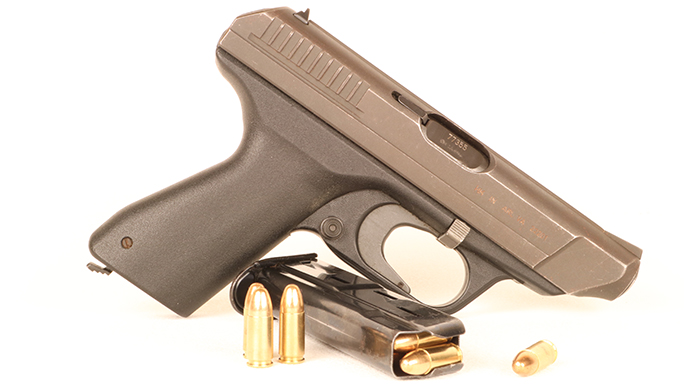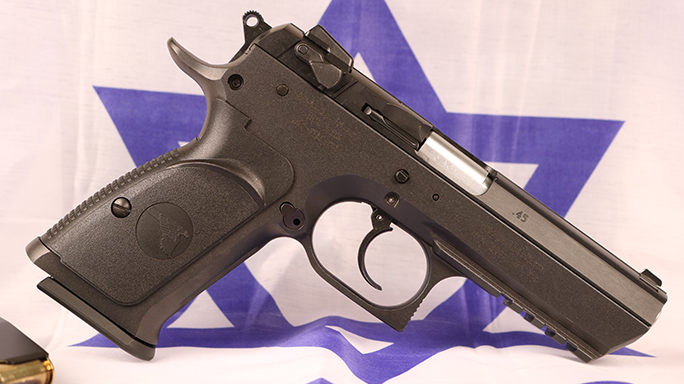I tend to shiver just a bit at the titillating sensation of steel against flesh just as much as the next rabid gun nerd. Believe me, I get it. I really do. Feeling the recoil of those fat .45 ACP rounds through the checkered mainspring housing of my favorite 1911 inevitably bumps my serum testosterone up a few points. However, clinging dogmatically to our steel and aluminum handguns in the Year of our Lord 2017 is starting to look just a little bit sad.
Even this deep into the Information Age you still bump into that rare Neanderthal who can’t download apps or program his microwave. Such unfortunate luddites are cursed to a lifetime of flip phones and incessantly blinking household appliances. Don’t be that guy.
Advertisement — Continue Reading Below
I think we can safely say that polymer pistols are no passing fad. There are certainly still plenty of new-production heaters sporting steel or aluminum frames. Heck, 1911 pistols will still be rolling off the lines when the world’s last Glock finally gets recycled into Wal-Mart shopping bags, packing foam, or whatever it is recycled plastic actually gets recycled into. However, it’s time for us old farts to get with the program. Until they come up with something even snazzier, tomorrow’s cool new combat guns will inevitably be made out of plastic.
Semantics and the Inexorable Power of Progress
We use the terms plastic and polymer interchangeably at times, but the word plastic was initially an adjective, not a noun. Plastic deformation is what happens when a material deforms and then retains its deformed shape. The antonym is elastic. Elastic defines a material that, once deformed, springs back into its original configuration. As it relates to guns, plastic simply describes a synthetic material that can be molded into complex shapes. Early plastics were flimsy. Today’s advanced polymers are, by contrast, phenomenally robust.
While polymer pistol frames do not permanently change shape when fired, they do tend to flex just a smidgeon. This tiny bit of springiness helps ameliorate recoil to a degree just not seen with yesterday’s metal-framed heaters. As they do not corrode like metals, polymer materials are also mightily environmentally resistant. Additionally, advanced polymers can be molded into hand-friendly shapes. To conjure the same shapes out of a metallic medium would be difficult, if not impossible. Combine this with the cost-effectiveness of molded polymers and you have a recipe for staying power in the gun world.
Advertisement — Continue Reading Below
But Will Polymer Pistols Really Last?
The geriatric HK VP70 — not to be confused with the contemporary VP9 and VP40 pistols — was really the world’s first sort-of successful polymer framed pistol. The VP70 entered service in 1970, a full 12 years before Mr. Glock’s eponymous handgun. It was intended to be an inexpensive machine pistol that could be distributed to partisans in the event the Soviet Union invaded Western Europe.
The VP70 handily wins the “Worst Trigger Ever” award for combat handguns. How heavy is this wretched double action-only trigger? I don’t know. About a hundred pounds would be my conservative estimate.
Beyond the atrociously heavy trigger, the VP70 used a really stout recoil spring to drive its unlocked blowback action. That made the gun fairly snappy in action and tough to rack. The double column magazine held 18 rounds, but shooting the gun more than a few times just wasn’t fun. The VP70 was designed to be cheap and easy to produce, not to be God’s gift to combat handgunning. What the VP70 does for us today, however, is yield some insights into how polymer pistol frames hold up over time.
Advertisement — Continue Reading Below
A Ballistic Time Capsule
My 40-year-old VP70 was not abused, but neither was it babied. Studying the gun yields insights into how polymer pistol frames might age should you wish to gift your favorite synthetic-framed combat handgun to your grandchildren. The results were encouraging.
The steel slide on my VP70 was treated with some HK-grade super finish that, while still intact, is liberally scuffed and scratched. This metric tells us that my VP70 was indeed knocked around a bit over the past half century. However, the polymer frame remains intact, attractive, and fully serviceable despite decades of hard use.
Advertisement — Continue Reading Below
While your kids’ Happy Meal toys will inevitably become landfill fodder — sometimes before the sun sets on the day of their purchase — polymer pistols are made from much more robust stuff. Our firearm components are typically reinforced with preternaturally strong synthetic fibers bonded within the polymer matrix that is just super tough. Imagine a fiberglass boat hull, and you have the idea.
Practical Tactical
For those diehard zealots among us who might yet insist that their carry gun be a full-sized steel-framed 1911 or nothing, I would invite you to undertake a simple test. Tote your favorite real steel 1911 through a few long days at work. Then undertake the same chore with a comparably-sized polymer-framed smoke pole. I do so love my tuned 1911 pistols, but packing a full-figured 1911 for a few days reminds us just what boat anchors these old hand cannons can be. Our forefathers toted guns such as these all across Europe and the Pacific. They did so while putting the holy smackdown on the greatest villains the planet has ever seen. However, those men were of better, tougher stock than are we today.
In addition to lighter weight and softer recoil, polymer pistols offer unprecedented versatility. My HK VP9, for instance, can accommodate most any grip size. Three backstraps along with six grip panels of various thicknesses allow this nifty pistol to fit your hand perfectly. I thicken mine on the right while thinning it on the left. The largest backstrap best accommodates my long monkey fingers.
Advertisement — Continue Reading Below
Ruminations on Polymer Pistols
I have more than half a century on my personal clock. I recall when telephones plugged into the wall and only cops and criminals carried guns. However, I have found we can choose to grow old gracefully or we can embrace the horror. Persist in clinging exclusively to antiquated steel hardware and Bermuda shorts, dentures, Bingo, and assisted living centers cannot be far behind.
Unless we want those tattooed young studs at the range to be snickering at us behind our backs we need to embrace plastic guns. When tucked into your belt these modern lightweight polymer pistols are way nicer on your lumbago than their retro steel counterparts. Easier to shoot, lighter to tote, and unflinchingly reliable, such stuff as this is clearly the wave of the future.




























